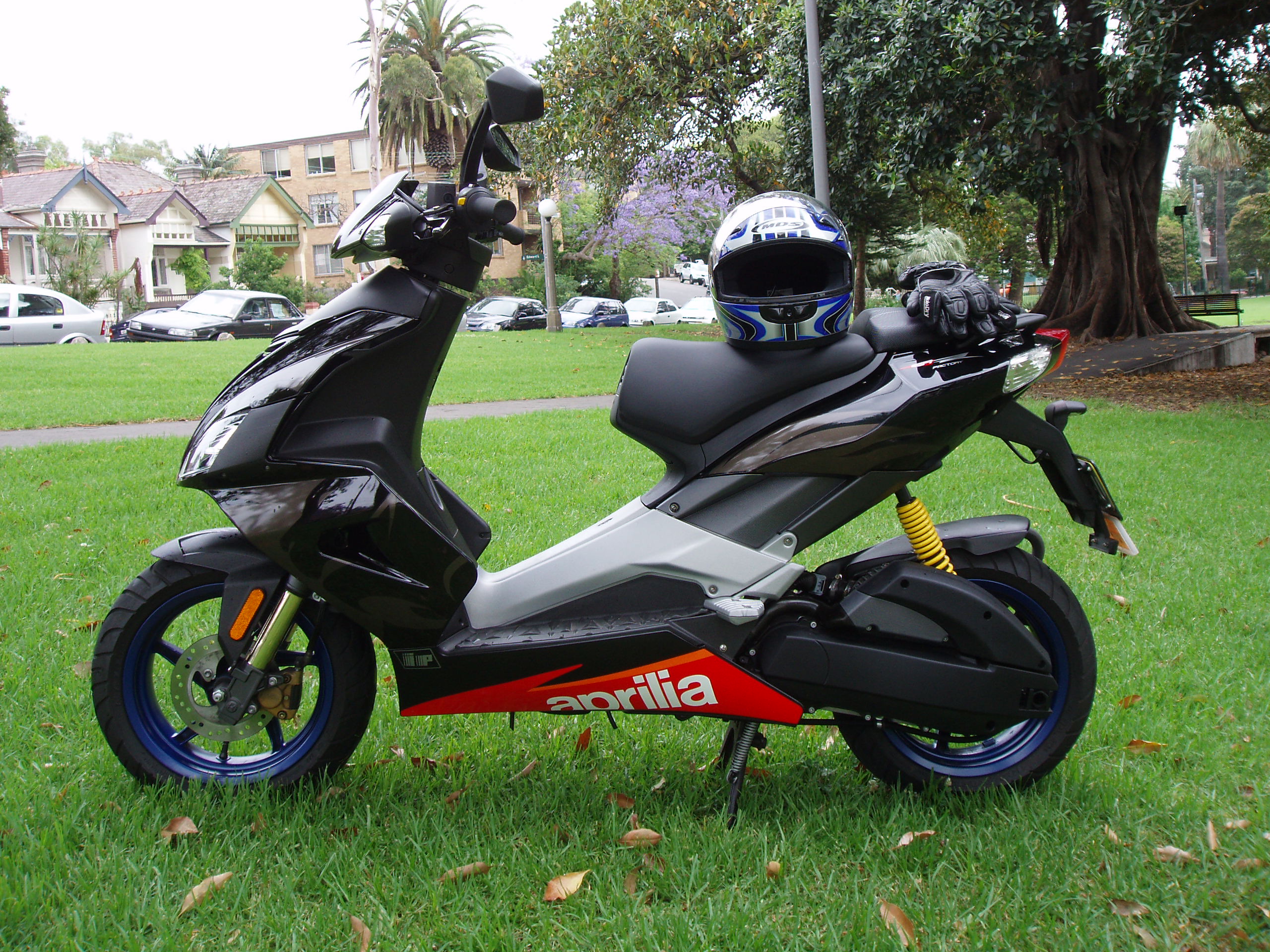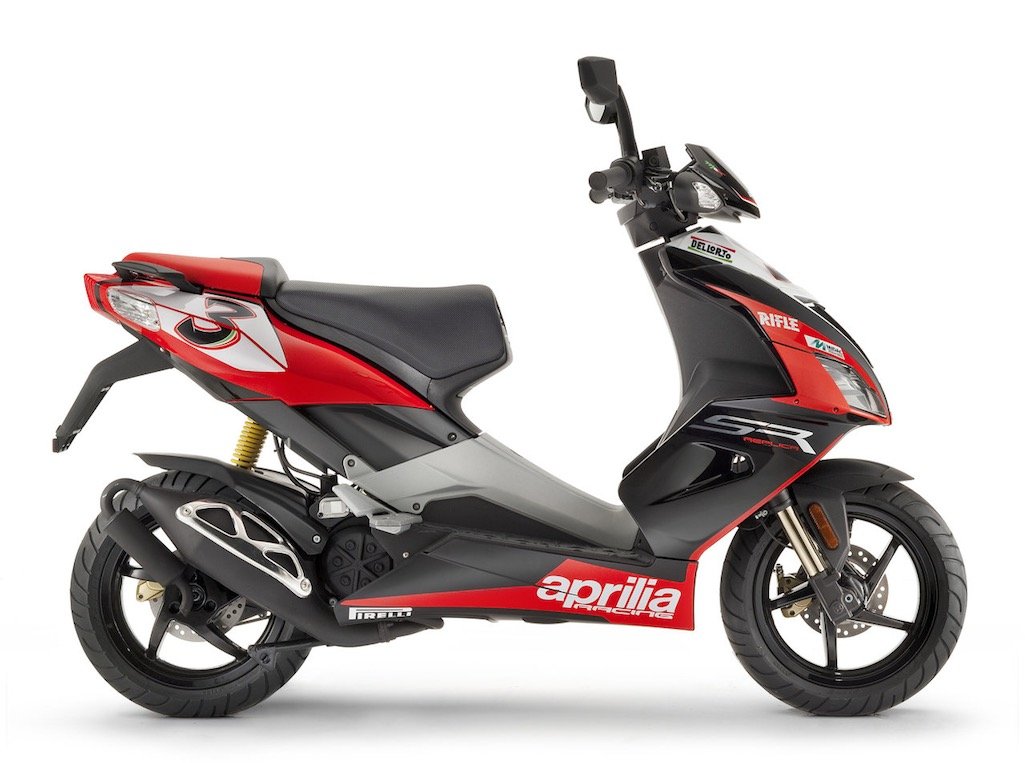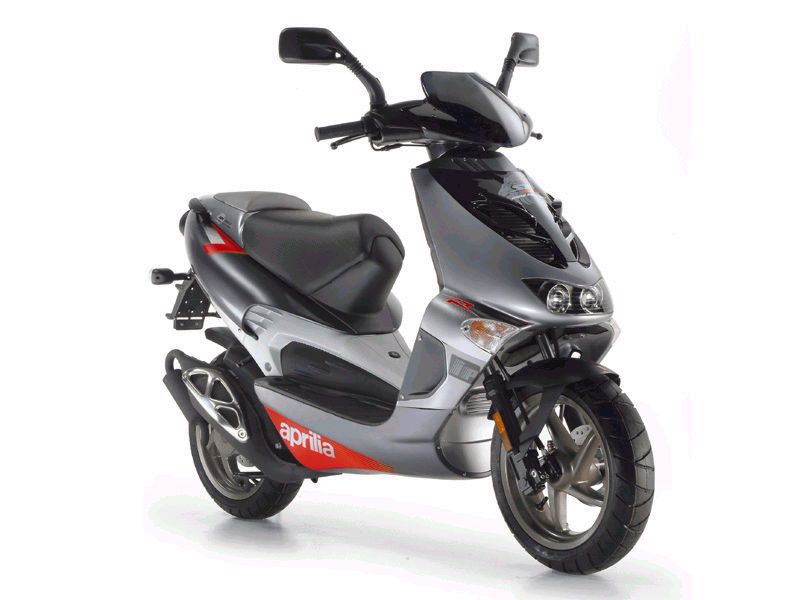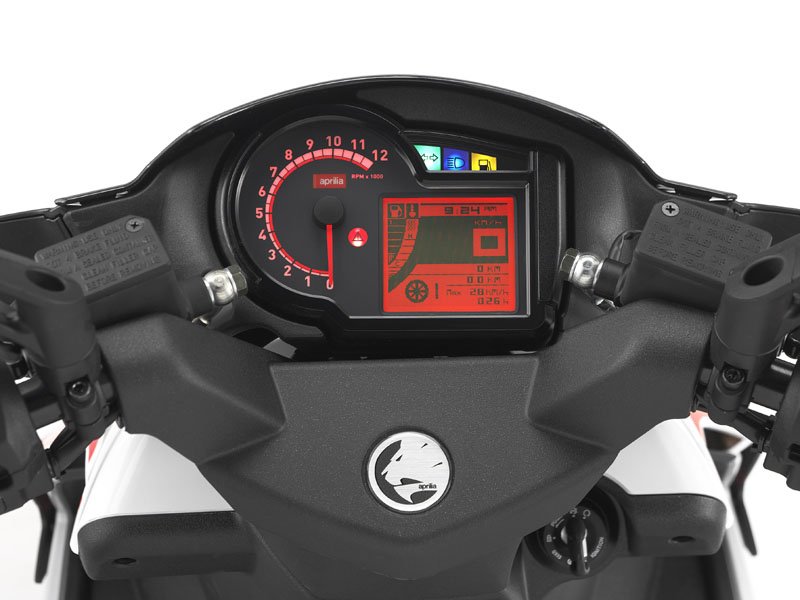Aprilia SR50
Since its European debut in 1992, the SR50 has been one of the most popular 50cc scooters worldwide, with over a million sold and a huge aftermarket community. The SR50 brought advanced technology, sporty style and huge power (for a 50cc) to the scooter scene. In North America the SR50 went on sale with Aprilia’s 1999 entry into the market and it remained on sale through two generations over 16 years, with 2015 being its final year here.
The SR50 was arguably the first ‘sports’ scooter due to its’ styling inspired by Aprilia’s larger bikes. Other landmark firsts accomplished by the SR50 include the first 50cc scooter with 13” rims, first scooter with direct fuel injection and the first 50cc with disc brakes front and rear. Aprilia also claims the SR50 was the first liquid cooled ‘sports scooter’, but it’s probably fair to give the nod to the 1983 Honda Beat for this. Regardless, Aprilia has poured a great deal of effort and innovation in the SR50. In today’s cluttered market of lower end machines, the SR50 stands out as a high quality machine for enthusiasts.
Generations
There has been two generations of the SR50, with a few different versions sold during each. The first SR50 (below) debuted overseas in 1992 but wouldn’t reach the USA & Canadian markets until the 1999. This original SR50 was first offered with a simple air-cooled carburated motor, but Aprilia added liquid cooling for 1994 and direct fuel injection for 1999. From 1999 to 2003, the original generation of SR50 was sold in both versions. The carburated version was called the SR50, while the direct fuel injection model was called the SR50 DiTech. Aprilia also varied the graphics on this generation of SR50 and used names like SR50 Sport and SR50 Racing to denote the different styling.
For the 2004 model year, Aprilia released an all new generation of SR50 (below) with edgier styling inspired by Aprilia’s flagship bike, the RSV1000.
This second generation of SR50 was produced in carburated (SR50 R) and direct fuel injection (SR50 R Factory) versions, but North American customers were only offered the higher end ‘Factory’ version with direct injection. Besides the new styling with the lion’s head graphics, the second generation SR50 also boasts a more rigid frame and a significantly improved DiTech system. Aprilia was able to double the maintenance intervals and reduce oil consumption by 60% with the refinements they made to the system. Power, milage and starting ease were all improved.
For 2010, Aprilia switched to a Piaggio made core engine but it still uses the same DiTech fuel system. For the 2013 model year, Aprilia offered a special edition called the Replica SBK dedicated to #3: Max Biaggi at no extra cost. The SR50 was dropped for Aprilia’s Canadian line up after 2014 and from the USA line up after 2015.
Engine
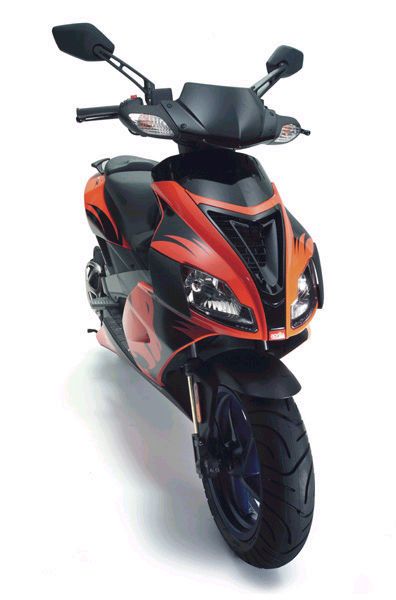
The SR50 is restricted in two ways. First, there is a restriction in the computer software that runs the highly advanced SR50. You can remove this yourself with a GameBoy (does anyone still have one of these?) or you can ask your dealer to switch it to ‘test’ or ‘development’ mode which removes the performance limitations. Secondly, there is also a restriction in the drivetrain that limits the top speed of the scooter by preventing it from reaching taller gear ratios. You can learn more about changing this here. Even if you don’t want to exceed the restricted speed of your SR50, you should still remove at least the computer restriction because with this in place, the scooter doesn’t rev high enough to accelerate with any authority. Restricted SR50’s make just under 2 horsepower.
Forgetting about legislated power restrictions, the SR50 has one awesome engine. Aprilia has sold the SR50 with three different motors (Minarelli, Aprilia/Morini and Piaggio) over its lifespan depending on the year and country you live in. North Americans were sold the Aprilia/Morini motor from the SR50’s debut here in 2001 until 2009, when the switch was made to the Piaggio engine. Piaggio (parent company of Vespa) bought Aprilia early in the new millennium (2004), so using a Piaggio powerplant is a way to lower costs. All SR50’s have liquid cooling and all the ones sold in North America have direct fuel injection (aka DiTech). Real world milage for the SR50 is really impressive at 80-90mpg. It’s almost as good as the fuel sipping 4-strokes 50’s out there while offering far more power. The only negatives with the SR50’s motor are the inherent downsides to a 2-stroke (emissions, shorter engine life). It’s common to give an SR50 a top end rebuild every few years, particularly if modified.
Brakes / Suspension / Handling
The disc brakes front and rear are an uncommon find on a 50cc. The SR50 offers perhaps the best braking of any 50cc sold here in North America. In a time when so many manufacturers cheap out on scooter brakes with low cost front drum brakes, the SR50 stands out with excellent discs at both ends. The lever feel is great and overall performance is second to none.
The handling of the SR50 is pretty good with its low profile tires and larger diameter wheels. The only thing that really holds this scooter back is the higher than average seating position. The high seat is comfortable for larger riders, but it means you’re sitting fairly high off the ground which gives a top heavy sensation. The SR50 has a lot of handling potential, but it takes a confident rider to get the most out of it. Most riders will adapt to this and find they can handle the SR50 well but shorter riders may find this to be a problem.
Storage & Convenience
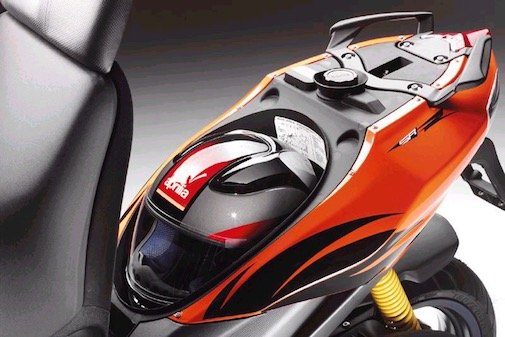
The bottom line is the SR50 is a great looking, powerful and top notch quality scooter that is sold at a premium price. The MSRP hovers around $3g in the USA and $4g in Canada ,which puts it on par with a 50cc Vespa and about $1000 more than quite a few other nice scooters. The SR50 certainly warrants its higher than average price tag due but it includes attributes that not every scooterist is after so consider carefully what suits your goals. The SR50 is really an enthusiasts machine. If you’re looking for slower practical transportation, something like Yamaha’s C3 has got the SR50 beat almost across the board (price, emissions, fuel economy, storage). The sporty styling, Aprilia quality and highly upgradeable nature of the SR50 seems to be what draws buyers to this scooter. If these attributes appeal to you then you’re going to love the SR50.
Pros:
- Unreal braking
- Class leading power
- Loads of go fast parts
- Huge community
- Sporty Styling
- Great mileage for a 2-stroke
Cons:
- High seat height
- Motor lifespan
Links:
SR50 Service Manual (2nd Generation) – Very helpful for the DIY’er mechanic.
SR50 DiTech Forums – Huge group of SR50 DiTech enthusiasts
MotorscooterGuide Forums – Visit the forum to chat about all things scooters.
ScooterSwapShop – Lots of SR50 performance parts
Key Specs:
- Engine: 49cc, single cylinder, liquid cooled, 2-stroke
- Compression: 12.5:1 (’92 – ’01), 11.5:1 (’04 – ’09), 12.1:1 (’10 – present)
- Bore x stroke: 41 x 37.4mm (Gen 1), 40.0 x 39.3 mm (2001 – present)
- Power: 5.35 horsepower (Generation 2)
- Fuel system: Direct fuel injection
- Ignition: CDI – capacitor discharge ignition
- Starter: Electric
- Frame: Steel
- Lubrication system: Oil injected
- Clutch: Automatic centrifugal dry clutch
- Weight: 199 lbs (Gen 1) , 198 lbs (Gen 2)
- Seat height: 32.0 (Gen 1), 32.2 (Gen 2)
- Overall height: 46.8” (Gen 1), 44.1” (Gen 2)
- Overall length: 73.5” (Gen 1), 73.2” (Gen 2)
- Overall width: 28.1” (Gen 1), 27.8” (Gen 2)
- Wheelbase: 49.3” (Gen 1), 50.8” (Gen 2)
- Front suspension: Hydraulic fork, 76mm wheel travel
- Rear suspension: Engine unit acting as swingarm, 72/70 (Gen 1/Gen 2) mm travel
- Rims: 3.5” x 13”, Five spoke, light alloy, tubeless
- Tires: 130/60-13 (front and rear)
- Brakes: Single 190mm disc, twin opposed 30mm pistons front and rear
- Fuel capacity: Gen 1 = 8 liters (2.1 gallon), Gen 2 = 7 litres (1.85 gallons)
- Gen 2 Color options: Aprilia White, Silver Crowd, Code Orange, Diablo Black
- Years offered: 1999 – 2014 (Canada), 1999 – 2015 (USA)
- MSRP: $3299 (2014 USA)

